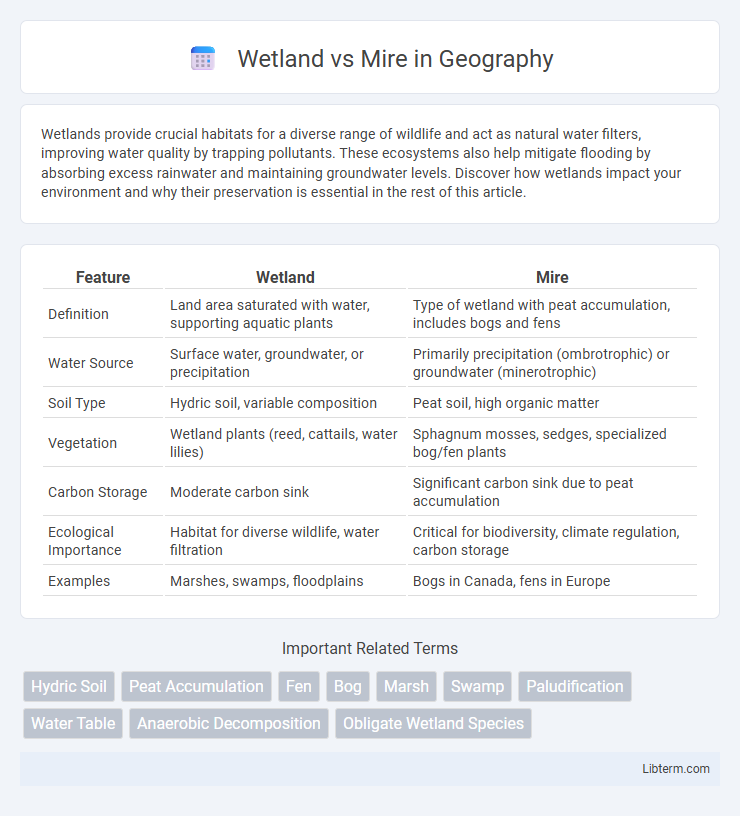Wetlands provide crucial habitats for a diverse range of wildlife and act as natural water filters, improving water quality by trapping pollutants. These ecosystems also help mitigate flooding by absorbing excess rainwater and maintaining groundwater levels. Discover how wetlands impact your environment and why their preservation is essential in the rest of this article.
Table of Comparison
| Feature | Wetland | Mire |
|---|---|---|
| Definition | Land area saturated with water, supporting aquatic plants | Type of wetland with peat accumulation, includes bogs and fens |
| Water Source | Surface water, groundwater, or precipitation | Primarily precipitation (ombrotrophic) or groundwater (minerotrophic) |
| Soil Type | Hydric soil, variable composition | Peat soil, high organic matter |
| Vegetation | Wetland plants (reed, cattails, water lilies) | Sphagnum mosses, sedges, specialized bog/fen plants |
| Carbon Storage | Moderate carbon sink | Significant carbon sink due to peat accumulation |
| Ecological Importance | Habitat for diverse wildlife, water filtration | Critical for biodiversity, climate regulation, carbon storage |
| Examples | Marshes, swamps, floodplains | Bogs in Canada, fens in Europe |
Introduction to Wetlands and Mires
Wetlands are ecosystems where water covers the soil or is present near the surface, supporting diverse plant and animal species adapted to saturated conditions. Mires, a specialized type of wetland, are peat-accumulating environments characterized by the slow decomposition of organic matter due to waterlogged, acidic, and low-nutrient conditions. Understanding the distinctions between wetlands and mires is crucial for ecological conservation, as mires play a significant role in carbon sequestration and habitat diversity.
Defining Wetlands: Key Features
Wetlands are ecosystems characterized by the presence of water, either permanently or seasonally, supporting hydrophytic vegetation and hydric soils. Mires, a specific type of wetland, are peat-accumulating environments where organic matter decomposition is slower than accumulation, creating unique acidic and waterlogged conditions. Key features of wetlands include water saturation, diverse plant species adapted to wet conditions, and critical roles in biodiversity support and water filtration.
Understanding Mires: Characteristics and Types
Mires are a specific type of wetland characterized by the accumulation of peat due to slow decomposition of plant material in water-saturated conditions. They are classified into two primary types: bogs, which receive water mainly from precipitation, and fens, which are nourished by groundwater rich in minerals. These unique hydrological and ecological characteristics make mires critical carbon sinks and biodiversity hotspots within wetland ecosystems.
Major Differences Between Wetlands and Mires
Wetlands are diverse ecosystems characterized by saturated soils and diverse plant communities, ranging from marshes and swamps to bogs and fens, while mires specifically refer to peat-accumulating wetlands such as bogs and fens with unique acidic or neutral conditions. Wetlands generally support a wide variety of vegetation and hydrological regimes, whereas mires form through the gradual buildup of organic peat deposits under waterlogged conditions, resulting in distinct ecological and hydrological processes. The major difference lies in peat accumulation, with mires acting as critical carbon sinks, unlike many other wetlands that may not develop significant peat layers.
Types of Wetlands: Marshes, Swamps, and Bogs
Wetlands are diverse ecosystems including marshes, swamps, and bogs, each characterized by distinct hydrology and vegetation. Marshes are nutrient-rich wetlands dominated by herbaceous plants, while swamps feature woody vegetation and are found in forested areas with standing water. Bogs are acidic, nutrient-poor wetlands with sphagnum moss, accumulating peat, and supporting unique plant species adapted to low fertility.
Mires: Peatlands Explained
Mires are a type of wetland characterized by the accumulation of organic matter, primarily peat, due to waterlogged conditions that slow decomposition. These peatlands are crucial carbon sinks, playing a significant role in climate regulation by storing vast amounts of carbon over millennia. Unlike other wetlands, mires maintain a delicate balance between water input and output, allowing them to sustain unique ecosystems and biodiversity.
Ecological Importance of Wetlands and Mires
Wetlands and mires serve crucial ecological functions including water purification, flood control, and carbon sequestration, with mires specifically acting as significant carbon sinks due to their accumulation of peat. Wetlands support high biodiversity, providing habitat for numerous species of plants, birds, fish, and invertebrates, while mires contribute to maintaining hydrological stability and nutrient cycling. The preservation of both wetlands and mires is essential for mitigating climate change impacts and sustaining ecosystem services critical to environmental health.
Biodiversity in Wetlands vs. Mires
Wetlands support a diverse array of plant and animal species due to their fluctuating water levels and nutrient availability, creating dynamic habitats for amphibians, birds, and aquatic plants. Mires, a type of wetland characterized by peat accumulation and acidic, nutrient-poor conditions, harbor specialized flora such as Sphagnum mosses and unique insect communities adapted to these environments. While wetlands generally promote high biodiversity through habitat heterogeneity, mires sustain distinctive ecological niches with specialized species that contribute to overall biodiversity in wetland ecosystems.
Conservation Challenges for Wetlands and Mires
Wetlands and mires face significant conservation challenges due to habitat loss, pollution, and climate change, which threaten their biodiversity and ecosystem services. Wetlands often suffer from drainage for agriculture and urban development, while mires are particularly vulnerable to peat extraction and altered hydrology. Effective conservation requires protecting water quality, restoring hydrological regimes, and implementing sustainable land-use practices to preserve these critical carbon sinks and biodiversity hotspots.
Conclusion: Comparing Wetlands and Mires
Wetlands represent a broad category of water-saturated ecosystems including marshes, swamps, and bogs, whereas mires specifically refer to peat-forming wetlands characterized by organic soil accumulation. The ecological functions of wetlands encompass water filtration, flood control, and wildlife habitat, with mires playing a crucial role in carbon sequestration and biodiversity preservation due to their unique acidic and nutrient-poor conditions. Understanding the distinctions between general wetlands and specialized mires enhances conservation strategies targeting habitat protection and climate change mitigation.
Wetland Infographic

 libterm.com
libterm.com